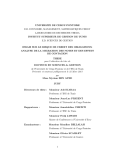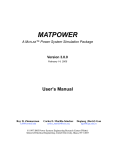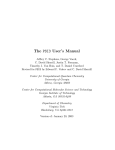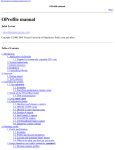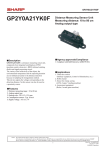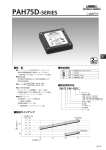Download The PSI3 Programmer`s Manual - Sherrill, C. David
Transcript
The PSI3 Programmer’s Manual T. Daniel Crawford,a C. David Sherrill,b Edward F. Valeev,b , Justin T. Fermann,c and C. Brian Kelloggc a Department of Chemistry, Virginia Tech, Blacksburg, Virginia 24061 b Center for Computational Molecular Science and Technology, Georgia Institute of Technology, Atlanta, Georgia 30332-0400 c Center for Computational Quantum Chemistry, University of Georgia, Athens, Georgia 30602-2525 Contents 1 Introduction 4 2 The PSI3Source Code 5 2.1 Introduction to the PSI3 Repository . . . . . . . . . . . . . . . . . . . . . . 5 2.2 Checking in altered PSI3 binaries or libraries . . . . . . . . . . . . . . . . . . 5 2.3 Adding entirely new code to the main PSI3 repository . . . . . . . . . . . . . 6 2.4 Updating checked out code . . . . . . . . . . . . . . . . . . . . . . . . . . . . 8 2.5 Removing code from the repository . . . . . . . . . . . . . . . . . . . . . . . 9 2.6 Checking out older versions of the code . . . . . . . . . . . . . . . . . . . . . 9 2.7 The structure of the PSI3 Source Tree . . . . . . . . . . . . . . . . . . . . . 10 3 Fundamental PSI3 Functions 10 3.1 The Structure of a PSI3 C Program . . . . . . . . . . . . . . . . . . . . . . . 11 3.2 The Input Parser . . . . . . . . . . . . . . . . . . . . . . . . . . . . . . . . . 13 3.2.1 Source Files . . . . . . . . . . . . . . . . . . . . . . . . . . . . . . . . 14 3.2.2 Syntax . . . . . . . . . . . . . . . . . . . . . . . . . . . . . . . . . . . 14 3.2.3 Sample Use from cscf . . . . . . . . . . . . . . . . . . . . . . . . . . 16 The Binary Input/Output System . . . . . . . . . . . . . . . . . . . . . . . . 17 3.3.1 The structure and philosophy of the library . . . . . . . . . . . . . . 17 3.3.2 The user interface . . . . . . . . . . . . . . . . . . . . . . . . . . . . . 18 3.3.3 Manipulating the table of contents . . . . . . . . . . . . . . . . . . . 19 3.3.4 Using libpsio.a . . . . . . . . . . . . . . . . . . . . . . . . . . . . . 19 3.3 4 Other PSI3 C Libraries 4.1 21 The Checkpoint File Library . . . . . . . . . . . . . . . . . . . . . . . . . . . 22 4.1.1 Library Philosophy . . . . . . . . . . . . . . . . . . . . . . . . . . . . 22 4.1.2 Basic Use Instructions . . . . . . . . . . . . . . . . . . . . . . . . . . 22 4.1.3 Initialization . . . . . . . . . . . . . . . . . . . . . . . . . . . . . . . . 24 4.1.4 Functions for reading information from the checkpoint file . . . . . . 24 4.2 The Integrals-With-Labels Library . . . . . . . . . . . . . . . . . . . . . . . 33 4.3 The “Quantum Trio” Library . . . . . . . . . . . . . . . . . . . . . . . . . . 33 5 Programming Style 33 2 5.1 On the Process of Writing Software . . . . . . . . . . . . . . . . . . . . . . . 34 5.2 Design Issues . . . . . . . . . . . . . . . . . . . . . . . . . . . . . . . . . . . 34 5.3 Organization of Source Code . . . . . . . . . . . . . . . . . . . . . . . . . . . 35 5.4 Formatting the Code . . . . . . . . . . . . . . . . . . . . . . . . . . . . . . . 36 5.5 Naming of Variables . . . . . . . . . . . . . . . . . . . . . . . . . . . . . . . 37 5.6 Printing Conventions . . . . . . . . . . . . . . . . . . . . . . . . . . . . . . . 37 5.7 Commenting Source Code . . . . . . . . . . . . . . . . . . . . . . . . . . . . 38 6 Makefiles in PSI3 39 6.1 Makefile Structure . . . . . . . . . . . . . . . . . . . . . . . . . . . . . . . . 39 6.2 PSI Makefiles . . . . . . . . . . . . . . . . . . . . . . . . . . . . . . . . . . 40 6.3 Preparing to Developing New PSI3 Code . . . . . . . . . . . . . . . . . . . . 41 7 Code Debugging 42 7.1 Code Re-compilation . . . . . . . . . . . . . . . . . . . . . . . . . . . . . . . 42 7.2 Multiple Source Code Directories . . . . . . . . . . . . . . . . . . . . . . . . 42 8 Documentation 43 A PSI3 Reference 44 B Text Files in PSI3 44 3 1 Introduction The PSI suite of ab initio quantum chemistry programs is the result of an ongoing attempt by a cadre of graduate students, postdoctoral associates, and professors to produce efficient and fast computer code. Some of the earliest contributions to what is now referred to as “PSI” include a direct configuration interaction (CI) program (Robert Lucchese, 1976, now at Texas A&M), the well-known graphical unitary group CI program (Bernie Brooks, 1977-78, now at N.I.H.), and the original integrals code (Russ Pitzer, 1978, now at Ohio State). From 19781987, the package was know as the BERKELEY suite, and after the Schaefer group moved to the Center for Computational Quantum Chemistry at the University of Georgia, the package was renamed PSI. Thanks primarily to the efforts of Curt Janssen (Sandia Labs, Livermore) and Ed Seidl (LLNL), the package was ported to UNIX systems, and substantially improved with new input formats and a C-based I/O system. Beginning in 1999, an extensive effort was begun to develop PSI3— a PSI suite with a completely new face. Nearly all of the code is now in C and C++, including new integral/derivative integral, coupled cluster, and CI codes. In addition, new I/O libraries have been added, as well as an improved checkpoint file structure and greater automation of typical tasks such as geometry optimization and frequency analysis. The package has the capability to determine wavefunctions, energies, analytic gradients, and various molecular properties based on a variety of theories, including spin-restricted, spin-unrestricted, and restricted open-shell Hartree-Fock (RHF, UHF, and ROHF); configuration interaction (CI) (including a variety of multireference CI’s and full CI); coupled-cluster (CC) including CC with variationaly optimized orbitals; second-order Møller-Plesset perturbation theory (MPPT) including explicitly correlated second-order Møller-Plesset energy (MP2-R12); and complete-active-space self-consistent field (CASSCF) theory. The purpose of this manual is to provide a reasonably detailed overview of the source code and programming philosophy of PSI3, such that programmers interested in contributing to the code will have an easier task. Section 2 gives a succint explanation of the steps required to obtain the source code from the main repository at Virginia Tech. (Installation instructions are given separately in the installation manual or in $PSI3/INSTALL.) Section 3 discusses the essential elements of a C-language PSI3 program, with emphasis on the input parsing and I/O functions. Section 4 provides documentation of a number of other important libraries, including the library of functions for reading from the checkpoint file, libchkpt.a, the Quantum Trio miscellaneous function library, libqt.a, the libiwl.a for reading and writing one- and two-electron integrals in the “integrals with labels” format. Section 5 offers advice on appropriate programming style for PSI3 code, and section 6 describes the structure of the package’s Makefiles. Section 6.3 gives a brief overview of the necessary steps to adding a new module to PSI3, section 7 gives some suggestions on debugging it, and section 8 explains conventions for documenting it. The appendices provide important reference material, including the currently accepted PSI3 citation and format information for some of the most important text files used by PSI3 modules. 4 2 The PSI3Source Code The concurrent versions system (CVS) (www.cvshome.org) provides a convenient means by which programmers may obtain the latest (or any previous) version of the PSI3 source from the main repository, add new code to the source tree or modify existing PSI3 modules, and then make changes and additions available to other programmers by checking the modifications back into the main repository. CVS also provides a “safety net” in that any erroneous modifications to the code may be easily removed once they have been identified. This section describes how to use CVS to access and modify the PSI3 source code. (Note that compilation and installation instructions are given in a separate document.) 2.1 Introduction to the PSI3 Repository The main repository for the PSI3 Source code is currently maintained by the Crawford group at Virginia Tech. To check out the code, one must first obtain a CVS account by emailing [email protected]. After you have a login-id and password, set the CVSROOT environmental variable for your shell to point to the main repository: For csh/tcsh: setenv CVSROOT :pserver:[email protected]:/home/users/psi3/master For sh/bash: CVSROOT=:pserver:[email protected]:/home/users/psi3/master export CVSROOT where login is your login name. Next, provide a password to the CVS server by typing cvs login. (Subsequent requests to the repository will not require you to re-login.) Check out a complete PSI3 source copy by running cvs co psi3 The working copy will be placed in the directory psi3. We will refer to this directory from now on as $PSI3. 2.2 Checking in altered PSI3 binaries or libraries If you have changes to Psi binaries or libraries which already exist, one of two series of steps is necessary to check these changes in to the main repository. The first series may be followed if all changes have been made only to files which already exist in the current version. The second series should be followed if new files must be added to the code in the repository. • No new files need to be added to the repository. We will use libciomr as an example. 5 1. cd $PSI3/src/lib/libciomr 2. cvs ci 3. Edit the comment file that CVS provides. • New files must be added to the repository. Again, we use libciomr as an example. Suppose the new file is named great code.c . 1. cd $PSI3/src/lib/libciomr 2. cvs add great code.c 3. cvs ci 4. Edit the comment file that CVS provides. The cvs ci command in both of these sequences will examine all of the code in the current libciomr directory against the current version of the code in the main repository. Any files which have been altered (and for which no conflicts with newer versions exist!) will be identified and checked in to the main repository (as well as the new file in the second situation). CVS will open a comment file for editing; you should enter a description of the changes you have made to the code here, as well as in the code itself. Exit the editing of the comment file, and CVS will check the new code into the main repository. 2.3 Adding entirely new code to the main PSI3 repository If the programmer is adding a new executable module or library to the PSI3 repository, a number of important conventions should be followed: 1. The directory containing the new code should be given a name which matches the name of the installed code (e.g. if the code will be installed as newcode, the directory containing the code should be named newcode). New executable modules must be placed in $PSI3/src/bin and libraries in $PSI3/src/lib of the user’s working copy. 2. The Makefile should be converted to an input file for the configure script (Makefile.in — see any of the current PSI3 binaries for an example) and should follow the conventions set up in all of the current PSI3 Makefiles. This includes use of MakeVars and MakeRules. 3. New binaries should be added to the list contained in $PSI3/src/bin/Makefile.in so that they will be compiled automatically when a full compilation of the PSI3 distribution occurs. This step is included in the sequence below. 4. A documentation page should be included with the new code (see section 8 for more information). As a general rule, if the code is not ready to have a documentation page, it is not ready to be installed in PSI3. 6 5. The configure.in file must be altered so that users may check out copies of the new code and so that the configure script will know to create the Makefile for the new code. These steps are included in the sequence below. Assume the new code is an executable module and is named great code. The directory containing the new code must contain only those files which are to be checked in to the repository! Then the following steps will check in a new piece of code to the main repository: 1. cd $PSI3/src/bin 2. cvs add great code 3. Answer “y” when CVS asks if you wish to create the new directory in the repository. 4. cd great code 5. cvs add * 6. cvs ci 7. Edit the comments file that CVS provides. 8. cd $PSI3 9. Edit configure.in and add great code to the list. 10. cvs ci 11. Edit the comments file that CVS provides. 12. autoconf 13. cd $PSI3/src/bin 14. Edit Makefile.in and add great code to the list. 15. cvs ci 16. Edit the comments file that CVS provides. At this point, all of the code has been properly checked in. However, you must test to make sure that the code can be checked out by other programmers, and that it will compile correctly. The following steps will store your personal version of the code, check out the new code, and test-compile it: 1. cd $PSI3/src/bin 2. mv great code great code.bak 3. cd $PSI3/.. 7 4. cvs co $PSI3/src/bin/great code 5. cd $objdir 6. $PSI3/configure --prefix=$prefix --verbose 7. cd src/bin/great code 8. make install (Note that $prefix and $objdir to the installation and compilation directories defined in the PSI3 installation instructions.) Your original version of the code remains under great code.bak, but should be no longer necessary if the above steps work. Note that it is necessary to re-run configure explicitly, instead of just running config.status, because the latter contains no information about the new code. 2.4 Updating checked out code If the code in the main repository has been altered, other users’ working copies will of course not automatically be updated. In general, it is only necessary to execute the following steps in order to completely update your working copy of the code: 1. cd $PSI3 2. cvs update -dP This will examine each entry in your working copy and compare it to the most recent version in the main repository. When the file in the main repository is more recent, your version of the code will be updated. If you have made changes to your version, but the version in the main repository has not changed, the altered code will be identified to you with an “M”. If you have made changes to your version of the code, and one or more newer versions have been updated in the main repository, CVS will examine the two versions and attempt to merge them – this process usually has conflicts however, and is sometimes unsuccessful. You will be notified of any conflicts that arise (labelled with a “C”) and you must resolve them manually. The -dP flags to cvs above will also ensure that any directories added to or removed from the main repository are also added or deleted in your working copy. Keep in mind, however, that the appearance of new directories will require you to re-run the configure script to compile the new codes. For example, 1. cd $PSI3 2. cvs update -dP 3. autoconf 8 4. cd $objdir 5. $PSI3/configure --prefix=$prefix --verbose 6. cd src/bin/great code 7. make install This will check out any new code that has been added to the repository since the last time the cvs update command was issued, correctly update the configure script (assuming the programmer who added the code followed the steps from section 2.3 and edited the configure.in file), re-configure for the new code (note that you must run configure and not config.status here), and then compile the code. 2.5 Removing code from the repository If alterations of libraries or binaries under Psi involves the deletion of source code files from the code, these must be explicitly removed through CVS. The following steps will remove a source code file named bad code.F from a binary module named great code: 1. cd $PSI3/src/bin/great code 2. rm bad code.F 3. cvs remove bad code.F 4. cvs ci 5. Edit the comments file that CVS provides. 2.6 Checking out older versions of the code It is sometimes necessary to check out older versions of a piece of code. Assume we wish to check out an old version of detci. If this is the case, the following steps will do this: 1. cd $PSI3/src/bin/detci 2. cvs update -D"2 months ago" This will check the main repository and provide you with the code as it stood exactly 2 months ago. CVS is quite impressive in this respect: It will accept all sorts of input to the -D option. You could even use -D"a fortnight ago" and CVS would get the correct version. (But it doesn’t get "two fortnights ago" right.) You can always get the recent version back by simply using -D"now" or -A. Note that subsequent updates of the current code will use the same date you give with the -D option. (See the CVS documentation about so-called “sticky tags”.) 9 2.7 The structure of the PSI3 Source Tree Your working copy of the PSI3 source code includes a number of important subdirectories: • $PSI3/lib – Source files for OS-independent “library” data. This includes the main basis set data file (pbasis.dat) and the PSI3 program execution control file (psi.dat), among others. These files are installed in $prefix/share. • $PSI3/include – Source files for OS-independent header files, including physconst.h (whose contents should be obvious from its name), psifiles.h, and ccfiles.h, among others. These files are installed in $prefix/include. • $PSI3/src/util – Source code for the utility program tocprint. (Note that the tmpl module is no longer used and will eventually disappear.) • $PSI3/src/lib – Source code for the libraries, including libpsio, libipv1, libchkpt, etc. • $PSI3/src/lib – Source code for the executable modules. After compilation and installation, the $prefix directory contains the executable codes and other necessary files. NB: The files in this area should never be directly modified; rather, the working copy should be modified and the PSI3 Makefile hierarchy should handle installation of any changes. The structure of the installation area is: • $prefix/bin – The main executable directory. This directory must be in your path in order for the driver program, psi3, to find the modules. • $prefix/lib – The PSI3 code libraries. (NB: The description of PSI3 Makefiles later in this manual will explain how to use the libraries.) • $prefix/include – Header files. (NB: Proper use of these will be explained later in the manual.) • $prefix/share – OS-independent data files, including basis set information. (Do not edit this file directly; any changes you make can be overwritten by subsequent make commands.) • $prefix/doc – PSI3 documentation, including installation, programmer, and user manuals. 3 Fundamental PSI3 Functions Each PSI3 module (e.g. cscf) must perform two specific tasks, regardless of the individual module’s specific purpose(s): (1) obtaining user input options and (2) writing to and reading from binary files (e.g. the checkpoint file). PSI3 programs written in the C programming 10 language make use of two libraries which provide all the tools necessary to carry out these functions: • libipv1.a — the input parser • libpsio.a — the I/O interface In addition, the libraries libciomr.a and libqt.a provide important functions for memory allocation, mathematics, and code timing. In the next section, we will discuss the basic components of a PSI3 C-language program, followed by detailed descriptions of the input parsing and I/O libraries. 3.1 The Structure of a PSI3 C Program To function as part of the PSI package, a program must incorporate certain required elements. This section will discuss the header files, global variables, and functions required to integrate a C program into PSI3. Figure 1 presents a minimal PSI3 program, whose elements are described below. The required include files are libipv1/ip lib.h, libciomr/libciomr.h, libpsio/psio.h, and of course stdio.h. The first of these is for the Input Parser Library, Version 1 (libipv1.a), which is described in section 3.2. The second file contains function prototypes for the C Math Routines and old-style I/O library, libciomr.a. The third file analogously provides clean interface to functions of the new C I/O system described in section 3.3. The PSI libraries require that infile, outfile, and psi file prefix be global variables. The integer function main() must be able to handle command-line arguments required by the PSI3 libraries. In particular, all PSI3 modules must be able to pass to the function psi start() arguments for the user’s input and output filenames, as well as a global file prefix to be used for naming standard binary and text data files. (NB: the default names for user input and output are input.dat and output.dat, respectively, though any name may be used.) The current standard for command-line arguments is for all module-specific arguments (e.g., --quiet, used in detci) before the input, output, and prefix values. The psi start() function expect to find only these last three arguments at most, so the programmer should pass as argv[] the pointer to the first non-module-specific argument. The above example is appropriate for a PSI3 module that requires no command-line arguments apart from the input/output/prefix globals. See the PSI3 modules input and detci for more sophisticated examples. The final argument to psi start() is an integer whose value indicates whether the output file should be overwitten (1) or appended (0). Most PSI3 modules should choose to append. The psi start() function initializes the user’s input and output files and sets the global variables infile, outfile, and psi file prefix, based on (in order of priority) the above command-line arguments or the environmental variables PSI INPUT, PSI OUTPUT, and PSI PREFIX. The value of the global file prefix can also be specified in the user’s input file. The psi start() function will also initialize the input parser and sets up a default 11 #include #include #include #include <stdio.h> <libipv1/ip_lib.h> <libpsio/psio.h> <libciomr/libciomr.h> FILE *infile, *outfile; char *psi_file_prefix; int main(int argc, char *argv[]) { extern char *gprgid(void); psi_start(argc-1, argv+1, 0); ip_cwk_add(gprgid()); psio_init(); /* to start timing, tstart(outfile); */ /* Insert code here */ /* to end timing, tstop(outfile); */ psio_done(); psi_stop(); } char *gprgid(void) { char *prgid = ":CODE_NAME"; return(prgid); } Figure 1: The essential elements of a PSI3 C-language program. 12 keyword tree (described in detail in section 3.2). This step is required even if the program will not do any input parsing, because some of the functionality of the input parser is assumed by libciomr.a and libpsio.a. For instance, opening a binary file via psio open() (see section 3.3) requires parsing the files section of the user’s input so that a unit number (e.g. 52) can be translated into a filename. The psi stop() function shuts down the input parser and closes the user’s input and output files. Timing information (when the program starts and stops, and how much user, system, and wall-clock time it requires) can be printed to the output file by adding calls to tstart() and tstop() (from libciomr.a). The sole purpose of the simple function gprgid() is to provide the input parser a means to determine the name of the current program. This allows the input parser to add the name of the program to the input parsing keyword tree. This function is used by libpsio.a, though the functionality it provides is rarely used. NB: The library libciomr.a contains older I/O functions that have been superceded by functions in libpsio.a. However, you are encouraged to use the many non-I/O functions in libciomr.a. 3.2 The Input Parser The input parsing library is built for the purpose of reading in the contents of an input file with the syntax of input.dat and storing the contents specific to certain keywords supplied. To perform such a task libipv1.a has three parts: (1) the parser; (2) the lexical scanner; (3) keyword storage and retrieval. The format of input.dat follows certain rules which should probably referred to as the PSI input grammar. There is a description of most of those rules in PSI3 User’s Manual. A complete definition of the PSI input grammar is encoded in parse.y (see below). To read a grammar we need a parser – the first component of libipv1.a. Then the identified lexical elements of input.dat (keywords and keyword values) need to be scanned for presence of “forbidden” characters (e.g. a space may not be a part of a string unless the string is placed between parentheses). This task is performed by the lexical scanner — the second component of libipv1.a. Finally, scanned-in pairs of keyword-value(s) are stored in a hierarchical data structure (a tree). When a particular option is needed, the set of stored keywords and values is searched for the one queried and the value returned. In this way, options of varying type can be assigned, i.e. rather than having a line of integers, each corresponding to a program variable, mnemonic character string variables can be parsed and interpreted into program variables. It’s also easier to implement default options, allowing a more spartan input deck. The set of input-parsing routines in libipv1.a is really not complicated to use, but the manner in which data is stored is somewhat painful to grasp at first. The following is a list of the names of the individual source files in libipv1 and a summary of their contents. After that is a list of the syntax of specific functions and their use. Last is a simple illustration of the use of this library, taken mostly from cscf. 13 3.2.1 Source Files • Header files – ip error.h Defines for error return values. – ip global.h cpp macros to make Curt happy. – ip lib.h #include’s everything. – ip types.h Various structures and unions specific to libipv1. • Other Source – parse.y Yacc source encoding the PSI input grammar. Read by yacc (or bison) – a parser generator program. – scan.l Lex source describing lexical elements allowed in input.dat. Read by lex (or flex) – a lexer generator program. – *.gbl, *.lcl cpp macros to mimic variable argument lists. • C source – ip alloc.c Allocates keyword tree elements. – ip cwk.c Routines to manipulate the current working keyword tree. – ip data.c Routines to handle reading of arrays and scaler keyword assignments in input. – ip error.c Error reporting functions. – ip karray.c Other things to deal with keyword arrays. – ip print.c Routines to print sections of the keyword tree. – ip read.c All the file manipulation routines. Reading of input.dat and building the keyword tree from which information is later plucked. 3.2.2 Syntax ip cwk.c void ip cwk clear(); Clears current working keyword. Used when initializing input or switching from one section to another (:DEFAULT and :CSCF to :INTCO, for instance). void ip cwk add(char *kwd); Adds kwd to current working keyword. Allows parsing of variables under that keyword out of the input file which has been read. ip data.c 14 int ip count(char *kwd, int *count, int n); Counts the elements in the n’th element of the array kwd. int ip boolean(char *kwd, int *bool, int n); Parses n’th element of kwd as boolean (true, 1, yes; false, 0, no) into 1 or 0 returned in bool. int ip exist(char *kwd, int n); Returns 1 if n’th element of kwd exists. Unfortunately, n must be 0. int ip data(char *kwd, char *conv, void *value, int n [, int o1, ..., int on]); Looks for keyword kwd, finds the value associated with it, converts it according to the format specification given in conv, and stores the result in value. Note that value is a void * so this routine can handle any data type, but it is the programmer’s responsibility to ensure that the pointer passed to this routine is of the appropriate pointer type for the data. The value found by the input parser depends on the value of n and any optional additional arguments. n is the number of additional arguments. If n is 0, then there are no additional arguments, and the keyword has only one value associated with it. If the keyword has an array associated with it, then n is 1 and the one additional argument is which element of the array to pick. If kwd specifies an array of arrays, then n is 2, the first additional argument is the number of the first array, and the second argument is the number of the element within that array, etc. Deep in here, the code calls a sscanf(read, conv, value);, so that’s the real meaning of variables. int ip string(char *kwd, char **value, int n, [int o1, ..., int on]); Parses the string associated with kwd stores it in value. The role of n and optional arguments is the same as that described above for ip data(). int ip value(char *kwd, ip value t **ip val, int n); Grabs the section of keyword tree at kwd and stores it in ip val for the programmer’s use this is usually not used, since you need to understand the structure of ip value t. int ip int array(char *kwd, int *arr, int n); Reads n integers into array arr. ip read.c void ip set uppercase(int uc); Sets parsing to case sensitive if uc==0, I think. void ip initialize(FILE *in, FILE *out); Calls yyparse(); followed by ip cwk clear(); followed by ip internal values();. This routine reads the entire input deck and stores it into the keyword tree for access later. void ip append(FILE *in, FILE *out); Same thing as ip initialize();, except this dosn’t clear the cwk first. Used for parsing another input file, such as intco.dat. void ip done(); Frees up the keyword tree. 15 3.2.3 Sample Use from cscf These are two slightly simplified pieces of actual code. From cscf.c: #include <libipv1/ip_lib.h> ffile(&infile,"input.dat",2); ffile(&outfile,"output.dat",1); /* input and output files. */ /* call them whatever you want. */ ip_set_uppercase(1); ip_initialize(infile,outfile); /* case sensitivity selection */ /* reads input.dat and stores it all */ ip_cwk_add(":DEFAULT"); ip_cwk_add(":SCF"); /* adds default section */ /* adds scf section */ ip_string("OUTPUT",&output,0); /* bet you didn’t know you could */ if(!strcmp(output,"TERMINAL")) { /* have cscf write to stdout! */ outfile = stdout; } else if(!strcmp(output,"WRITE")) { fclose(outfile); ffile(&outfile,"output.dat",0); } From scf input.c: errcod = ip_string("LABEL",&alabel,0); if(errcod == IPE_OK) fprintf(outfile," reordr = 0; label = %s\n",alabel); /* easy to set default - if not specified, then */ /* this line changes nothing */ errcod = ip_boolean("REORDER",&reordr,0); if(reordr) { errcod = ip_count("MOORDER",&size,0); for(i=0; i < size ; i++) { errcod = ip_data("MOORDER","%d",&iorder[i],1,i); errchk(errcod,"MOORDER"); } } second_root = 0; if (twocon) { errcod = ip_boolean("SECOND_ROOT",&second_root,0); } 16 if(iopen) { errcod = ip_count("SOCC",&size,0); if(errcod == IPE_OK && size != num_ir) { fprintf(outfile,"\n SOCC array is the wrong size\n"); fprintf(outfile," is %d, should be %d\n",size,num_ir); exit(size); } if(errcod != IPE_OK) { fprintf(outfile,"\n try adding some electrons buddy!\n"); fprintf(outfile," need SOCC\n"); ip_print_tree(outfile,NULL); exit(1); } 3.3 3.3.1 The Binary Input/Output System The structure and philosophy of the library Almost all PSI3 modules must exchange data with raw binary (also called “direct-access”) files. However, rather than using low-level C or Fortran functions such as read() or write(), PSI3 uses a flexible, but fast I/O system that gives the programmer and user control over the organization and storage of data. Some of the features of the PSI I/O system, libpsio, include: • A user-defined disk striping system in which a single binary file may be split across several physical or logical disks. • A file-specific table of contents (TOC) which contains file-global starting and ending addresses for each data item. • An entry-relative page/offset addressing scheme which avoids file-global file pointers which can limit file sizes. The TOC structure of PSI binary files provdes several advantages over older I/O systems. For example, data items in the TOC are identified by keyword strings (e.g., "Nuclear Repulsion Energy") and the global address of an entry is known only to the TOC itself, never to the programmer. Hence, if the programmer wishes to read or write an entire TOC entry, he/she is required to provide only the TOC keyword and the entry size (in bytes) to obtain the data. Furthermore, the TOC makes it possible to read only pieces of TOC entries (say a single buffer of a large list of two-electron integrals) by providing the appropriate TOC keyword, a size, and a starting address relative to the beginning of the TOC entry. In short, the TOC design hides all information about the global structure of the direct access file from the programmer and allows him/her to be concerned only with the structure of individual entries. The current TOC is written to the end of the file when it is closed. 17 Thus the direct-access file itself is viewed as a series of pages, each of which contains an identical number of bytes. The global address of the beginning of a given entry is stored on the TOC as a page/offset pair comprised of the starting page and byte-offset on that page where the data reside. The entry-relative page/offset addresses which the programmer must provide work in exactly the same manner, but the 0/0 position is taken to be the beginning of the TOC entry rather than the beginning of the file. 3.3.2 The user interface All of the functions needed to carry out basic I/O are described in this subsection. Proper declarations of these routines are provided by the header file psio.h. Note that before any open/close functions may be called, the input parsing library, libipv1 must be initialized so that the necessary file striping information may be read from user input, but this is hidden from the programmer in lower-level functions. NB, ULI is used as an abbreviation for unsigned long int in the remainder of this manual. int psio init(void): Before any files may be opened or the basic read/write functions of libpsio may be used, the global data needed by the library functions must be initialized using this function. int psio done(void): When all interaction with the direct-access files is complete, this function is used to free the library’s global memory. int psio open(ULI unit, int status): Opens the direct access file identified by unit. The status flag is a boolean used to indicate if the file is new (0) or if it already exists and is being re-opened (1). If specified in the user input file, the file will be automatically opened as a multivolume (striped) file, and each page of data will be read from or written to each volume in succession. int psio close(ULI unit, int keep): Closes a direct access file identified by unit. The keep flag is a boolean used to indicate if the file’s volumes should be deleted (0) or retained (1) after being closed. int psio read entry(ULI unit, char *key, char *buffer, ULI size): Used to read an entire TOC entry identified by the string key from unit into the array buffer. The number of bytes to be read is given by size, but this value is only used to ensure that the read request does not exceed the end of the entry. If the entry does not exist, an error is printed to stderr and the program will exit. int psio write entry(ULI unit, char *key, char *buffer, ULI size): Used to write an entire TOC entry idenitified by the string key to unit into the array buffer. The number of bytes to be written is given by size. If the entry already exists and its data is being overwritten, the value of size is used to ensure that the write request does not exceed the end of the entry. int psio read(ULI unit, char *key, char *buffer, ULI size, psio address sadd, psio address *eadd): Used to read a fragment of size bytes of a given TOC entry identified by key from unit into the array buffer. The starting address is given by the sadd and the ending address (that is, the entry-relative address of the next byte in the file) is returned 18 in *eadd. int psio write(ULI unit, char *key, char *buffer, ULI size, psio address sadd, psio address *eadd): Used to write a fragment of size bytes of a given TOC entry identified by key to unit into the array buffer. The starting address is given by the sadd and the ending address (that is, the entry-relative address of the next byte in the file) is returned in *eadd. The page/offset address pairs required by the preceeding read and write functions are supplied via variables of the data type psio address, defined by: typedef struct { ULI page; ULI offset; } psio_address; The PSIO ZERO defined in a macro provides a convenient input for the 0/0 page/offset. 3.3.3 Manipulating the table of contents In addition, to the basic open/close/read/write functions described above, the programmer also has a limited ability to directly manipulate or examine the data in the TOC itself. int psio tocprint(ULI unit, FILE *outfile): Prints the TOC of unit in a readable form to outfile, including entry keywords and global starting/ending addresses. (tocprint is also the name of a PSI3 utility module which prints a file’s TOC to stdout.) int psio toclen(ULI unit, FILE *outfile): Returns the number of entries in the TOC of unit. int psio tocdel(ULI unit, char *key): Deletes the TOC entry corresponding to key. NB that this function only deletes the entry’s reference from the TOC itself and does not remove the corresponding data from the file. Hence, it is possible to introduce data ”holes” into the file. int psio tocclean(ULI unit, char *key): Deletes the TOC entry corresponding to key and all subsequent entries. As with psio tocdel(), this function only deletes the entry references from the TOC itself and does not remove the corresponding data from the file. This function is still under construction. 3.3.4 Using libpsio.a The following code illustrates the basic use of the library, as well as when/how the psio init() and psio done() functions should be called in relation to initialization of libipv1. (See section 3.1 later in the manual for a description of the basic elements of C-language PSI3 program.) #include <stdio.h> 19 #include <libipv1/ip_lib.h> #include <libpsio/psio.h> #include <libciomr/libciomr.h> FILE *infile, *outfile; int main() { int i, M, N; double enuc, *some_data; psio_address next; /* Special page/offset structure */ ffile(&infile,"input.dat",2); ffile(&outfile,"output.dat",1); ip_set_uppercase(1); ip_initialize(infile,outfile); ip_cwk_add(":DEFAULT"); ip_cwk_add(progid); /* Initialize the I/O system */ psio_init(); /* Open the file and write an energy */ psio_open(31, PSIO_OPEN_NEW); enuc = 12.3456789; psio_write_entry(31, "Nuclear Repulsion Energy", (char *) &enuc, sizeof(double)); psio_close(31,1); /* Read M rows of an MxN matrix from a file */ some_data = init_matrix(M,N); psio_open(91, PSIO_OPEN_OLD); next = PSIO_ZERO;/* Note use of the special macro */ for(i=0; i < M; i++) psio_read(91, "Some Coefficients", (char *) (some_data + i*N), N*sizeof(double), next, &next); psio_close(91,0); /* Close the I/O system */ psio_done(); ip_done(); } 20 char *gprgid() { char *prgid = "CODE_NAME"; return(prgid); } The interface to the PSI3 I/O system has been designed to mimic that of the old wreadw() and wwritw() routines of libciomr (see the next section of this manual). The table of contents system introduces a few complications that users of the library should be aware of: • As pointed out earlier, deletion of TOC entries is allowed using psio tocdel() and psio tocclean(). However, since only the TOC reference is removed from the file and the corresponding data is not, a data hole will be left in the file if the deleted entry was not the last one in the TOC. A utility function designed to ”defrag” a PSI file may become necessary if such holes ever present a problem. • One may append data to an existing TOC entry by simply writing beyond the entry’s current boundary; the ending address data in the TOC will be updated automatically. However, no safety measures have been implemented to prevent one from overwriting data in a subsequent entry thereby corrupting the TOC. This feature/bug remains because (1) it is possible that such error checking functions may slow the I/O codes significantly; (2) it may be occasionally desirable to overwrite exiting data, regardless of its effect on the TOC. Eventually a utility function which checks the validity of the TOC may be needed if this becomes a problem, particularly for debugging purposes. 4 Other PSI3 C Libraries There are several other PSI C libraries besides the previously-mentioned libipv1.a, libpsio.a, and libciomr.a: libchkpt.a This library provides many routines for reading from and writing to the “checkpoint” file, file30. There is generally a different function associated with each quantity in file30 (such as the SCF energy, nuclear repulsion energy, geometry, basis set information, etc). This library uses the libpsio.a library to do its input and output. It replaces an older library libfile30.a which served the same purpose but which used the old I/O from libciomr.a. libiwl.a The new format for storing two-electron integrals is IWL, or “integrals with labels.” The library libiwl.a provides functions for reading and writing files in the IWL format. The code was written with the goal that it could be easily modified to allow for more than 256 basis functions. Its current limit is 32768 basis functions. libqt.a This is the “Quantum Trio” library, which contains a number of very experimental functions or functions which don’t otherwise fit anywhere else. In this section we will consider these libraries in greater detail. 21 4.1 4.1.1 The Checkpoint File Library Library Philosophy The libchkpt.a library is a collection of functions used to access the PSI3 checkpoint file (file32) – the file which contains all most frequently used information about the computation such as molecular geometry, basis set, HF determinant, etc. Previously, the checkpoint file was a fixed-format file which is accessed using the old PSI3 I/O system. However, this changed in the spring of 2002 to use the new libpsio.a I/O system to access the checkpoint file, and it is now free format. That is, any programmer can add content to the file at will. The old checkpoint file interface has been updated to access the new underlying I/O system. It is mandatory that the checkpoint file is accessed via the libchkpt.a functions only. 4.1.2 Basic Use Instructions Following the philosophy that a programmer who wants to read, say, the number of atoms and the irrep labels from the checkpoint file should not have to use fifty lines of code to do so, libchkpt.a was written. Following a call to a single command, chkpt init(), the programmer can extract many useful bits of info from the checkpoint file relatively painlessly. libchkpt.a is dependent upon libipv1.a and libpsio.a and thus requires that the input parser and I/O system each be initialized so that the proper file name labels may be referenced. An example of a minimal program that sets up the input parser, initilizes a special structure within the libchkpt.a library, and reads the SCF HF energy, eigenvector and eigenvalues is given below. In order to illustrate the writing capability of the library routines, a dummy correlated energy is written to the checkpoint file and then read back again within the code. #include #include #include #include #include <stdio.h> <libipv1/ip_lib.h> <libciomr/libciomr.h> <libpsio/psio.h> <libchkpt/chkpt.h> FILE *infile, *outfile; void main(void) { int nmo; double escf, etot; double *evals; double **scf; /*------------------------------------22 initialize the input parser, read in the files information from the default section -------------------------------------*/ ffile(&infile,"input.dat",2); ffile(&outfile,"output.dat",1); tstart(outfile); ip_set_uppercase(1); ip_initialize(infile,outfile); ip_cwk_clear(); ip_cwk_add(":DEFAULT"); psio_init(); /*-----------------------------------now initialize the checkpoint structure and begin reading info ------------------------------------*/ chkpt_init(); escf = chkpt_rd_escf(); evals = chkpt_rd_evals(); scf = chkpt_rd_scf(); nmo = chkpt_rd_nmo(); chkpt_wt_etot(-1000.0); etot = chkpt_rd_etot(); chkpt_close(); /*-------------------------------------------print out info to see what has been read in --------------------------------------------*/ fprintf(outfile,"\n\n\tEscf = %20.10lf\n",escf); fprintf(outfile,"\tEtot = %20.10lf\n",etot); fprintf(outfile,"SCF EIGENVECTOR\n"); eivout(scf,evals,nmo,nmo,outfile); psio_done(); tstop(outfile); ip_done(); } /*------------------------------------------------23 dont forget to add the obligatory gprgid section -------------------------------------------------*/ char *gprgid() { char *prgid = ":TEST"; return(prgid); } 4.1.3 Initialization int chkpt init() Initializes the checkpoint struct to allow other chkpt * functions to perform their duties. Arguments: none, but it requires that the input parser be initialized so that it can open the checkpoint file. Returns: zero. Perhaps this will change some day. int chkpt close() Closes the checkpoint file, frees memory, etc. Arguments: none, but chkpt init must already have been called for this to work. Returns: zero. Perhaps this, too, will change one day. 4.1.4 Functions for reading information from the checkpoint file This section gives an overview of many of the most widely used functions from libchkpt.a. For more details and descriptions of newer functions that are not yet described here, see the source code itself. Functions that return char* char *chkpt rd corr lab() Reads in a label from the checkpoint file which describes the wavefunction used to get the correlated energy which is stored in the checkpoint file (see chkpt rd ecorr()). Arguments: takes no arguments. Returns: a string, like ”CISD”, or ”MCSCF” or some other wavefunction designation. char *chkpt rd label() Reads the main the checkpoint file label. Arguments: takes no arguments. Returns: calculation label. char *chkpt rd sym label() Reads the label for the point group. Arguments: takes no arguments. Returns: point group label. 24 Functions that return char** char **chkpt rd irr labs() Read in the symmetry labels for all irreps in the point group in which the molecule is considered. Arguments: takes no arguments. Returns: an array of labels (strings) which denote the irreps for the point group in which the molecule is considered, regardless of whether there exist any symmetry orbitals which transform as that irrep. char **chkpt rd hfsym labs() Read in the symmetry labels only for those irreps which have basis functions. Arguments: takes no arguments. Returns: an array of labels (strings) which denote the irreps which have basis functions (in Cotton ordering). For DZ or STO-3G water, for example, in C 2v symmetry, this would be an array of three labels: ”A1”, ”B1”, and ”B2”. Functions that return int int chkpt rd iopen() Reads in the dimensionality (up to a sign) of ALPHA and BETA vectors of two-electron coupling coefficients for open shells (see chkpt rd ccvecs()). Note : iopen = MM * (MM + 1), where MM is the total number of irreps containing singly occupied orbitals. Arguments: takes no arguments. Returns: the +/- dimensionality of ALPHA and BETA vectors of coupling coefficients for open shells. int chkpt rd max am() Reads in the maximum orbital quantum number of AOs in the basis. Arguments: takes no arguments. Returns: the maximum orbital quantum number of AOs in the basis. int chkpt rd mxcoef() Reads the value of the constant mxcoef. Arguments: takes no arguments. Returns: the sum of the squares of the number of symmetry orbitals for each irrep. This gives the number of elements in the non-zero symmetry blocks of the SCF eigenvector. For STO-3G water mxcoef= (4 ∗ 4) + (0 ∗ 0) + (1 ∗ 1) + (2 ∗ 2) = 21. int chkpt rd nao() Reads in the total number of atomic orbitals (read: Cartesian Gaussian functions). Arguments: takes no arguments. Returns: total number of atomic orbitals. int chkpt rd natom() Reads in the total number of atoms. 25 Arguments: takes no arguments. Returns: total number of atoms. int chkpt rd ncalcs() Reads in the total number of calculations in the checkpoint file (was always 1 in old libfile30.a, probably still is for now). Arguments: takes no arguments. Returns: total number of calculations in the checkpoint file. int chkpt rd nirreps() Reads in the total number of irreducible representations in the point group in which the molecule is being considered. Arguments: takes no arguments. Returns: total number of irreducible representations. int chkpt rd nmo() Reads in the total number of molecular orbitals (may be different from the number of basis functions). Arguments: takes no arguments. Returns: total number of molecular orbitals. int chkpt rd nprim() Reads in the total number of primitive Gaussian functions (only primitives of symmetry independent atoms are counted!). Arguments: takes no arguments. Returns: total number of primitive Gaussian functions. int chkpt rd nshell() Reads in the total number of shells. For example, DZP basis set for carbon atom (contraction scheme [9s5p1d/4s2p1d]) has a total of 15 basis functions, 15 primitives, and 7 shells. Shells of all atoms are counted (not only of the symmetry independent; compare chkpt rd nprim). Arguments: takes no arguments. Returns: total number of shells. int chkpt rd nso() Reads in the total number of symmetry-adapted basis functions (read: Cartesian or Spherical Harmonic Gaussians). Arguments: takes no arguments. Returns: total number of SOs. int chkpt rd nsymhf() Reads in the total number of irreps in the point group in which the molecule is being considered which have non-zero number of basis functions. For STO-3G or DZ water, for example, this is three, even though nirreps is 4 (compare int chkpt rd nirreps()). Arguments: takes no arguments. Returns: total number of irreducible representations with a non-zero number of basis functions. int chkpt rd num unique atom() Reads in the number of symmetry unique atoms. 26 Arguments: takes no arguments. Returns: number of symmetry unique atoms. int chkpt rd num unique shell() Reads in the number of symmetry unique shells. Arguments: takes no arguments. Returns: number of symmetry unique shells. int chkpt rd phase check() Reads the phase flag, which is 1 if the orbital phases have been checked and is 0 otherwise (phase checking just helps ensure the arbitrary phases of the orbitals are consistent from one geometry to the next, which helps various guessing or extrapolation schemes). Arguments: takes no arguments. Returns: flag. int chkpt rd ref() Reads the reference type from the flag in the checkpoint file. 0 = RHF, 1 = UHF, 2 = ROHF, 3 = TCSCF. Arguments: takes no arguments. Returns: flag indicating the reference. int chkpt rd rottype() Reads the rigid rotor type the molecule represents. 0 = asymmetric, 1 = symmetric, 2 = spherical, 3 = linear, 6 = atom. Arguments: takes no arguments. Returns: rigid rotor type. Functions that return int* int *chkpt rd am2canon shell order() Reads in the the mapping array from the angmom-ordered to the canonical (in the order of appearance) list of shells. Arguments: takes no arguments. Returns: an array nshell long that maps shells from the angmom-ordered to the canonical (in the order of appearance) order. chkpt rd atom position() Reads in symmetry positions of atoms. Allowed values are as follows: • 1 - atom in a general position • 2 - atom on the c2z axis • 4 - atom on the c2y axis • 8 - atom on the c2x axis • 16 - atom in the inversion center • 32 - atom in the sigma xy plane 27 • 64 - atom in the sigma xz plane • 128 - atom in the sigma yz plane This data is sufficient to define stabilizers of the nuclei. Arguments: takes no arguments. Returns: an array of symmetry positions of atoms. int *chkpt rd clsdpi() Reads in an array which has an element for each irrep of the point group of the molecule (n.b. not just the ones with a non-zero number of basis functions). Each element contains the number of doubly occupied MOs for that irrep. Arguments: takes no arguments. Returns: the number of doubly occupied MOs per irrep. int *chkpt rd openpi() Reads in an array which has an element for each irrep of the point group of the molecule (n.b. not just the ones with a non-zero number of basis functions). Each element contains the number of singly occupied MOs for that irrep. Arguments: takes no arguments. Returns: the number of singly occupied MOs per irrep. int *chkpt rd orbspi() Reads in the number of MOs in each irrep. Arguments: takes no arguments. Returns: the number of MOs in each irrep. int *chkpt rd shells per am() Reads in the number of shells in each angmom block. Arguments: takes no arguments. Returns: the number of shells in each angmom block. chkpt rd sloc() Read in an array of pointers to the first AO from each shell. Arguments: takes no arguments. Returns: Read in an array nshell long of pointers to the first AO from each shell. chkpt rd sloc new() Read in an array of pointers to the first basis function (not AO as chkpt rd sloc does) from each shell. Arguments: takes no arguments. Returns: an array nshell long of pointers to the first basis function from each shell. int *chkpt rd snuc() Reads in an array of pointers to the nuclei on which shells are centered. Arguments: takes no arguments. Returns: an array nshell long of pointers to the nuclei on which shells are centered. int *chkpt rd snumg() Reads in array of the numbers of the primitive Gaussians in the shells. 28 Arguments: takes no arguments. Returns: an array nshell long of the numbers of the primitive Gaussians in shells. int *chkpt rd sprim() Reads in pointers to the first primitive from each shell. Arguments: takes no arguments. Returns: an array nshell long of pointers to the first primitive from each shells. chkpt rd sopi() Read in the number of symmetry-adapted basis functions in each symmetry block. Arguments: takes no arguments. Returns: an array nirreps long of the numbers of symmetry orbitals in symmetry blocks. int *chkpt rd stype() Reads in angular momentum numbers of the shells. Arguments: takes no arguments. Returns: Returns an array nshell long of the angular momentum numbers of the shells. int *chkpt rd symoper() Read in the mapping array between ”canonical” ordering of the symmetry operations of the point group and the one defined in symmetry.h. Arguments: takes no arguments. Returns: a mapping array nirrep long int *chkpt rd ua2a() Read in the mapping array from the symmetry-unique atom list to the full atom list. Arguments: takes no arguments. Returns: a mapping array num unique atom long int *chkpt rd us2s() Read in the mapping array from the symmetry-unique shell list to the full shell list. Arguments: takes no arguments. Returns: a mapping array num unique shell long Functions that return int** int **chkpt rd ict() Reads the transformation properties of the nuclei under the operations allowed for the particular symmetry point group in which the molecule is considered. Arguments: takes no arguments. Returns: a matrix of integers. Each row corresponds to a particular symmetry operation, while each column corresponds to a particular atom. The value of ict[2][1], then, should be interpreted in the following manner: application of the third symmetry operation of the relavant point group, the second atom is placed in the location originally occupied by the atom number ict[2][1]. int **chkpt rd shell transm() 29 Reads in the transformation matrix for the shells. Each row of the matrix is the orbit of the shell under symmetry operations of the point group. Arguments: takes no arguments. Returns: a matrix of nshell*nirreps integers. Functions that return double double chkpt rd ecorr() Reads in the correlation energy stored in the checkpoint file. To get some information (a label) on the type of correlated wavefunction used to get this energy, see chkpt rd corr lab(). Arguments: takes no arguments. Returns: the correlation energy. double chkpt rd enuc() Reads in the nuclear repulsion energy Arguments: takes no arguments. Returns: the nuclear repulsion energy. double chkpt rd eref() Reads in the reference energy (may be different from HF energy). Arguments: Returns: double chkpt rd Reads in the SCF takes no arguments. the reference energy. escf() HF energy. Arguments: takes no arguments. Returns: the SCF HF energy. double chkpt rd etot() The total energy, be it HF, CISD, CCSD, or whatever! This is the preferred function to use for geometry optimization via energies, printing energies in analysis, etc., since this value is valid whatever the calculation type. Arguments: takes no arguments. Returns: The total energy. Functions that return double* double *chkpt rd evals() double *chkpt rd alpha evals() double *chkpt rd beta evals() Reads in the (spin-restricted HF, α UHF, and β UHF) eigenvalues: the orbital energies. Arguments: take no arguments. Returns: an array of all of the SCF eigenvalues, ordered by irrep, and by increasing energy within each irrep. (i.e. for STO-3G water, the four a1 eigenvalues all come first, and those four are ordered from lowest energy to highest energy, followed by the single b1 eigenvalue, etc. — Pitzer ordering) double *chkpt rd exps() Reads in the exponents of the primitive Gaussian functions. 30 Arguments: takes no arguments. Returns: an array of doubles. double *chkpt rd zvals() Reads in nuclear charges. Arguments: takes no arguments. Returns: an array natom long of nuclear charges (as doubles). Functions that return double** double **chkpt rd blk scf(int irrep) double **chkpt rd alpha blk scf(int irrep) double **chkpt rd beta blk scf(int irrep) Reads in a symmetry block of the (RHF, α UHF, β UHF) eigenvector. Arguments: int irrep, designates the desired symmetry block Returns: a square matrix has orbspi[irrep] rows. The eigenvectors are stored with the column index denoting MOs and the row index denoting SOs: this means that scf vector[i][j] is the contribution of the ith SO to the jth MO. double **chkpt rd ccvecs() Reads in a matrix rows of which are ALPHA (ccvecs[0]) and BETA (ccvecs[1]) matrices of coupling coefficients for open shells stored in lower triangular form. Coupling coefficients are defined NOT as in C.C.J.Roothaan Rev. Mod. Phys. 32, 179 (1960) as it is stated in the manual pages for CSCF, but according to Pitzer (no reference yet) and are **different** from those in Yamaguchi, Osamura, Goddard, and Schaefer’s book ”Analytic Derivative Methods in Ab Initio Molecular Electronic Structure Theory”. The relationship between the Pitzer’s and Yamaguchi’s conventions is as follows : ALPHA = 1-2*a , BETA = 1+4*b , where a and b are alpha’s and beta’s for open shells defined on pp. 69-70 of Dr. Yamaguchi’s book. Arguments: takes no arguments. Returns: double **ccvecs, a matrix 2 by abs(iopen) rows of which are coupling coefficient matrices for open-shells in packed form. For definition of iopen see chkpt rd iopen(). chkpt rd contr full() Reads in the normalized contraction coefficients. Arguments: takes no arguments. Returns: a matrix MAXANGMOM (a constant defined in ???) by the total number of primitives nprim; each primitive Gaussian contributes to only one shell (and one basis function, of course), so most of these values are zero. double **chkpt rd geom() Reads in the cartesian geometry. 31 Arguments: takes no arguments. Returns: The cartesian geometry is returned as a matrix of doubles. The row index is the atomic index, and the column is the cartesian direction index (x=0, y=1, z=2). Therefore, geom[2][0] would be the x-coordinate of the third atom. chkpt rd lagr() chkpt rd alpha lagr() chkpt rd beta lagr() Reads in an (RHF, α UHF, β UHF) Lagrangian matrix in MO basis. Arguments: takes no arguments. Returns: a matrix nmo by nmo. double **chkpt rd scf() double **chkpt rd alpha scf() double **chkpt rd beta scf() Reads in the (RHF, α UHF, β UHF) eigenvector. Arguments: takes no arguments. Returns: a square matrix of dimensions nmo by nmo (see: chkpt rd nmo()). The symmetry blocks of the SCF vector appear on the diagonal of this matrix. chkpt rd schwartz() Reads in the table of maxima of Schwartz integrals (ij—ij) for each shell doublet. Arguments: takes no arguments. Returns: NULL if no table is present in the checkpoint file, a matrix nshell by nshell otherwise. chkpt rd usotao new() Reads in an AO to SO transformation matrix. Arguments: takes no arguments. Returns: a nso by nao matrix of doubles. chkpt rd usotbf() Reads in a basis function to SO transformation matrix. Arguments: takes no arguments. Returns: a nso by nso matrix of doubles. Functions that return struct *z entry The z-matrix is read from the checkpoint file as an array of z entry structs which are declared in chkpt.h. This structure contains the reference atom, an optimization flag, the coordinate value, and any label used for each internal coordinate. When not applicable (such as the first few lines of a z-matrix) atom variables are given values of -1, opt variables are given values of -1, val variables are given values of -999.9, and label strings are left empty. chkpt rd zmat() Reads in the z-matrix Arguments: takes no arguments. Returns: struct *z entry natom long. 32 4.2 The Integrals-With-Labels Library The library libiwl.a contains functions for reading and writing to files with the ”Integrals With Labels” (IWL) format created by David Sherrill in 1994, modeled after the format of the old integrals file from PSI2. Most functions deal with four-index quantitites, but there are also a few which deal with two-index quantities such as one-electron integrals. The IWL format specifies that the 4-index quantities are stored on disk in several buffers; each buffer has a header segment which gives some useful info. Currently, the header is arranged as follows: one integer word is used as a flag, telling whether the current buffer is the last buffer in the file. The next integer gives the number of integrals (and their associated labels) in the current buffer. After this header information, each buffer contains two data segments: one for labels, and one for the values of the associated integrals. The datasize for the labels is defined using typedefs, so it is easy to change (currently, it is a short int); likewise for the integral values (currently of type double). The length of these data segments is NBUF * 4 * sizeof(Label) and NBUF * sizeof(Value), respectively. The current use of short ints for Label is really somewhat excessive, making the files somewhat larger than strictly necessary. However, this avoids confusing bit-packing schemes, and instantly allows us to have up to something like 65,536 basis functions addressable. The functions previously documented in this manual have been removed because that documentation is now out of date. Documentation of the library is now created directly from the source code using the doxygen program and is available at http://vergil.chemistry.gatech.edu/psi/de 4.3 The “Quantum Trio” Library The libqt.a library is a miscellaneous collection of useful math and other routines. The documentation previously found in this manual of libqt.a functions has been removed and is now obsolete. The current documentation of this library is generated automatically from the doxygen program and is available on the website at http://vergil.chemistry.gatech.edu/psi/devel/li 5 Programming Style In the context of programming, style can refer to many things. Foremost, it refers to the format of the source code: how to use indentation, when to add comments, how to name variables, etc. It can also refer to many other issues, such code organization, modularity, and efficiency. Of course, stylistic concerns are often matters of individual taste, but often validity and portability of the code will ultimately depend on stylistic decisions made in the process of code development. Hence some stylistic choices are viewed as universally bad (e.g. not prototyping every function just because “the code compiles and runs fine as is”, etc.). Admittedly, it is easy to not have any style, but it takes years to learn what makes a good one. A good programming style can reduce debugging and maintenance times dramatically. For a large package such as PSI3, it is very important to adopt a style which makes the code easy to understand and modify by others. This section will give a few brief pointers on what 33 we consider to be a good style in programming. 5.1 On the Process of Writing Software At first, we feel appropriate to touch upon the issue of programming style as referred to the approach to writing software. Often, “programming” is used to mean “the process of writing software”. In general one has to distinguish “writing software” from “programming” meaning “implementation”, because the latter is only a part of the former and does not include documentation, etc. In general, “writing software” should consist of five parts: 1. Get a clear and detailed understanding of what the code has to do (idea); 2. Identify key concepts and layout code and data organization (design); 3. Write source code (implementation); 4. Test the program and eliminate errors and/or design flaws (testing); 5. Write documentation (documentation). Thus, writing software is significantly more complex than just coding. Each stage of writing software is as important as others and should not be considered a waste of time. The code written without a detailed understanding of what it has to do may not work properly. Poorly designed code may not be flexible enough to accomodate some new feature and will be rewritten. Poorly implemented code may be too slow to be useful. A paper full of incorrect values produced by your code may get you fired and will destroy your reputation. A documentation-free code will most likely be useless for others. Of course, for very simple programs design and implementation may be combined and documentation may consist of one line. However, for more complex programs it is recommended that the five stages are followed. This means that you should spend only about 20-40% of your time writing source code! Our experience shows that following this scheme results in the most efficient approach to programming in the long run. To learn more on each stage of the software writing process, you may want to refer to Stroustrup’s “C++ Programming Language” book (3rd Ed.) as the most common reference source not dedicated solely to one narrow subject. Besides being an excellent description of C++, it is also an introduction to writing software as well. Particular attention is paid to the issue of program design. 5.2 Design Issues Although C lacks the most powerful features of C++ as far as concepts and data organization is concerned, Stroustrup says: “Remember that much programming can be simply and clearly done using only primitive, data structures, plain functions, and a few library classes.” This means that one can write many useful and well-written programs in C. Here are a few pointers that will assist you in structuring your C program: 34 • Identify groups of variables having common function (e.g. basis set, etc.) and organize them into structures. Use several levels of hierarchy if necessary (e.g. a basis set is a collection of basis functions each of which may be described by a structure). This is called “hierarchical ordering”. • Think as generally as possible. What you may not need today will be asked for tomorrow. Design data structures that are flexible and modular, i.e. one can be easily modified without affecting the others (e.g. you do not want the structure describing basis sets to know anything about the type of basis functions it contains so that plane waves can be used as easily as Gaussians). • Write “constructors” for the structures, i.e. functions which will initialize data in the structures (e.g. read basis set information). Make as many “constructors” as necessary (e.g. basis set info can be read from the checkpoint file or from pbasis.dat). If it is difficult or impossible to write a “constructor” for some data structure is a sign that your data hierachy is poorly designed and there are mutual dependencies. Spend more time designing the system. If it doesn’t help, then use source code comments heavily to describe the relationships not reflected in the code itself. • Use global variables sparringly. Placing a variable into global scope leaves it unprotected against “unauthorized” use or modification (we are not talking about security here; it is a good idea to protect data from the programmer, because if you do not want some data A to be modified by function B, do not make A available to B) and may also have impact on program’s performance. Sometimes it is a good idea to use global data to reduce the cost of passing that data to a function. However, the same effect may be achieved by organizing that data into a local structure and passing the structure instead. • Learn how to use static variables local to a source file, it is a very powerful tool to protect data in a C program. • Organize the source code such as to emphasize further the structure of the program (see section 5.3). More material on data organization may be found in the Stroustrup’s book. 5.3 Organization of Source Code It is almost universally agreed that breaking the program up into several files is good style. An 11,592 line Fortran program, for example, is very inconvenient to work with, for several reasons: first, it can be difficult to locate a particular function1 or statement; second, every recompilation during debugging involves compiling the entire file. Having several small files generally makes it easier to find a particular piece of code, and only source files which have been modified need to be recompiled, greatly enhancing the efficiency of the programmer 1 Following the convention of C, the words function and subroutine will be used interchangeably. 35 during the debugging process. For smaller programs, it is recommended that the programmer have one file for each subroutine, giving each file the name of the subroutine (abbreviated filenames may be specified if the function names are too long). For larger programs, it may be helpful to group similar functions together into a single file. In C programs, we also consider it a good idea to place all the #include statements in a file such as includes.h, which is subsequently included in each relevant C source file. This is helpful because if a new header file needs to be added, it can simply be added to includes.h. Furthermore, if a source file suddenly needs to have access to a global variable or function prototype which is already present in one of the header files, then no changes need to be made; the header file is already included. A downside to this approach is that each header file is included in every source file which includes includes.h, regardless of whether a particular header file is actually needed by that source file; this could potentially lead to longer compile times, but it isn’t likely to make a discernable difference, at least in C.2 Along similar lines, it is helpful to define all global variables in one location (in the main program file, or else within globals.c), and they should be declared within another standard location (perhaps globals.h, or common.h). 3 Similarly, if functions are used in several different source code files, the programmer may wish to place all function prototype declarations in a single header file, with the same name as the program or library, or perhaps called protos.h. 5.4 Formatting the Code By formatting, we mean how many spaces to indent, when to indent, how to match up braces, when to use capital vs. lower case letters, and so forth. This is perhaps a more subjective matter than those previously discussed. However, it is certainly true that some formatting styles are easier to read than others. For already existing code, we recommend that you conform to the formatting convention already present in the code. The author of the code is likely to get upset when he sees that you’re incorporated code fragments with a formatting style which differs from his! On the other hand, in certain rare cases, it might be more beneficial to incorporate a different style: in the conversion of intder95 from old-style to new-style input, we used lower-case lettering instead of the all-caps style of the original program. This was very useful in helping us locate which changes we had made. It is very common that statements within loops are indented. Loops within loops are indented yet again, and so on. This practice is near-universal and very helpful. Computational chemistry programs often require many nested loops. The consequence of this is that lines can be quite long, due to all those spaces before each line in the innermost loops. If the lines become longer than 80 characters, they are hard to read within a single window; please try to keep your lines to 80 characters or less. This means that you should use about 2-4 spaces per indentation level. 2 3 C++, which includes much of the actual code in header files, is a different matter. See page 33 of Kernighan and Ritchie, 2nd Ed., for an explanation of definition vs. declaration. 36 Table 1: Some Variable Naming Conventions in PSI3 Quantity Variable(s) Number of atoms na, natom, num atoms Number of atoms * 3 natom3, num atoms3 Nuclear repulsion energy enuc, repnuc SCF energy escf Number of atomic orbitals nbfao, num ao Number of symmetry orbitals nbfso, num so Size of lower triangle of AO’s, SO’s nbatri, nbstri; ntri Input file pointer infile Output file pointer outfile Offset array ioff Number of irreps num ir, nirreps Open-shell flag iopen Number of orbitals per irrep orbs per irrep, orbspi, mopi Number of closed-shells per irrep docc, clsd per irrep, clsdpi Number of open-shells per irrep socc, open per irrep, openpi Orbital symmetry array orbsym The matching of braces, and so forth, is more variable, and we recommend you follow the convention of The C Programming Language, by Kernighan and Ritchie, or perhaps the style found in other PSI3modules. 5.5 Naming of Variables All non-trivial data must be given descriptive names, although extremely long names are discouraged. For example, compound variable names like num atoms or atom orbit degen should be preferred to nat or atord, so that non-specialists could understand the code. It is also a good idea to put a descriptive comment where a non-trivial variable is declared. However, simple loop indices should generally be named i,j,k or p,q,r. PSI3 programs have certain conventions in place for names of most common variables, as shown in the Table 1. 5.6 Printing Conventions At the moment, there isn’t really a standard method for a PSI program to determine how much information to print to output.dat. Some older PSI3 modules read a flag usually 37 Table 2: Proposed Conventions for Printing Level 0 Almost no printing; to be used by driver programs with -quiet option 1 Usual printing (default) 2 Verbose printing 3 Some debugging information 4 Substantial debugging information 5 Print almost all intermediates unless arrays too large 6 Print everything called IPRINT which is a decimal representation of a binary number. Each bit is a printing option (yes or no) for the different intermediates particular to the program. A practice which is probably preferable is to have a different print flag (boolean) for each of the major intermediates used by a program, and to have an overall print option (decimal) whose value determines the printing verbosity for the quantities without a specific printing option. The overall print option should be specified by a keyword PRINT LVL, and its action should be as in Table 2. 5.7 Commenting Source Code It is absolutely mandatory that each source file contains a reasonable number of comments. When a significant variable, data type, or function is declared, it must be accompanied with some descriptive information written in English. Every function prototype or body of it has to be preceeded by a short description of its purpose, algorithm (desirable; if it is too complex, provide a reference), what arguments it takes and what it returns. Having said this, we will argue against excessive commenting: don’t add a comment every time you do i++! It will actually make your code harder to read. Be sensible. As of spring 2002, we have adopted the doxygen program to automatically generate source code documentation. This program scans the source code and looks for special codes which tell it to add the given comment block to the documentation list. The program is very fancy and can generate documentation in man, html, latex, and rtf formats. The file psi3.dox is the doxygen configuration file. The source code should be commented in the following way to work with doxygen. The first file of each library defines a “module” via a special comment line: /*! \defgroup PSIO libpsio: The PSI I/O Library */ Note the exclamation mark above — it is required by doxygen. The line above defines the PSIO key and associates it with the title “The PSI I/O Library.” Each file belonging to this group will have a special comment of the following form: 38 /*! ** \file close.c ** \ingroup (PSIO) */ This tells doxygen that file close.c should be documented, it should be added to the list of documented files, and it belongs to the PSIO group. All functions should be commented as in the following: /*! ** PSIO_CLOSE(): Closes a multivolume PSI direct access file. ** ** \param unit = The PSI unit number used to identify the file to all read ** and write functions. ** \param keep = Boolean to indicate if the file should be deleted (0) or ** retained (1). ** ** Returns: always returns 0 ** ** \ingroup (PSIO) */ int psio_close(ULI unit, int keep) ... This will add the function psio close to the list, associate it with the PSIO module, and define the various arguments. 6 Makefiles in PSI3 The make utility is designed to help maintain the many components of a large program, such as PSI. This section will describe the construction and usefulness of Makefiles in PSI, both in developmental code and in production-level modules. We will be concerned only with the GNU Project’s make facility, and not older, less flexible versions. (For a complete explanation of GNU’s make, see info make or go to www.gnu.org). 6.1 Makefile Structure The primary purpose of the make program is to assist compilation and recompilation of a multi-file program, such that only those portions of the program are recompiled that require it. For example, if a header file is changed, then each source file which #includes that file must be recompiled. make provides an easy mechanism by which such dependencies (also called prerequisites) may be tracked. 39 Makefiles consist of rules which describe how to carry out commands. For example, a rule might explain how to compile a single source file, or how to link all the object files into the executable, or perhaps how to clean up all the object files. A rule has the following form target: dependencies command command ... The target is the name of the rule, e.g. the name of the program or file to be compiled. The first rule given in the Makefile is the default. The dependencies are the names of files (often names of other targets, as well) on which the construction of the target depends. A particular target does not necessarily have to have dependencies. The commands are the actual commands to be executed once all the dependencies are complete. Note that a <TAB> must be used to indent commands under the target name; if you use spaces or don’t indent you’ll get a (not entirely clear) error message. Makefiles may also contain variable definitions to make the file perhaps simpler. 6.2 PSI Makefiles The Makefiles contained in the PSI package are complicated, in part due to the size of the package and the need for code portability. PSI3 Makefiles are generated automatically from simple input, called Makefile.in, by the configure script in the top-level $PSI directory. This script is designed to examine system-specific characterisctics, such as library locations, special compiler options, the existence of certain header files or functions, or Fortran-C crosslinkage conventions, among others. With the information it obtains, it constructs the large number of Makefiles needed for compilation of PSI’s libraries, utilities, and modules. As an example, consider the Makefile.in file associated with cscf: srcdir = @srcdir@ VPATH = @srcdir@ include ../MakeVars PSILIBS = -lPSI_file30 -lPSI_chkpt -lPSI_iwl -lPSI_psio -lPSI_ciomr -lPSI_ipv1 TRUESRC = \ cscf.c cleanup.c dft_inputs.c diis.c dmat.c \ dmat_2.c ecalc.c errchk.c findit.c \ formg2.c formgc.c formgo.c form_vec.c gprgid.c init_scf.c \ packit_c.c packit_o.c rdone.c rdtwo.c rotate_vector.c scf_input.c \ scf_iter.c scf_iter_2.c schmit.c sdot.c shalf.c check_rot.c phases.c\ guess.c sortev.c occ_fun.c init_uhf.c cmatsplit.c dmatuhf.c \ findit_uhf.c uhf_iter.c schmit_uhf.c diis2_uhf.c formg_direct.c \ 40 orb_mix.c BINOBJ = $(TRUESRC:%.c=%.o) ALLOC = include ../MakeRules ifneq ($(DODEPEND),no) $(BINOBJ:%.o=%.d): $(DEPENDINCLUDE) include $(BINOBJ:%.o=%.d) endif install_man:: cscf.1 $(MKDIRS) $(mandir)/man1 $(INSTALL_INCLUDE) $^ $(mandir)/man1 The @string@ directives tell the configure script where to insert certain variables is has determined from the system. This Makefile input also includes two external Makefiles, MakeVars and MakeRules, both of which are in the parent directory. These files contain (not surprisingly) numerous necessary variables (e.g. the local C compiler name) and rules (e.g. how to generate the module itself) for compilation and installation of cscf. Similar files exist for the PSI libraries as well. We recommend that programmer’s spend some time studying the PSI Makefile structure. 6.3 Preparing to Developing New PSI3 Code Given the complexity of the PSI3 package, the prospect of adding new modules or libraries may seem daunting at first. Let’s assume you want to begin writing a new module named great code for PSI3. The following series of steps will generate the proper directories and Makefiles to get started. For convenience, the top-level directory of the programmer’s PSI3 source tree will be referred to as $PSI3 and the top-level directory of the compilation area as $prefix: 1. Generate the new directory in the source tree: mkdir $PSI3/src/bin/great code 2. cd $PSI3/src/bin/great code 3. Copy an existing Makefile.in from another module: cp ../cscf/Makefile.in . 4. Edit the Makefile.in so that it lists only the source files for great code and includes in PSILIBS only those libraries needed to link the executable. 5. Return to the top of the source tree: cd $PSI3 41 6. Add the name of great code’s Makefile to configure.in (near the bottom of the file) and run autoconf to generate a new configure script. 7. Go to the top of the compilation tree: cd $prefix. 8. Re-run the configure script to generate the Makefile for great code. Make sure you use the same options to configure that you used before or other Makefile’s may not function properly. The command you used before can be found in $prefix/config.status. (See also the PSI3 installation manual for more details on the options to configure.) Now you are ready to work on the code. Changes to source files (including the Makefile should be made to the files in $PSI3/src/bin/great code and all compilations should be run in $prefix/src/bin/great code. 7 Code Debugging Debugging PSI3 code using an interactive debugger, such as gdb or dbx can be difficult at times because of the complicated organization of this large program package. This section discusses some strategies and technical details of using such debuggers with the PSI3 code. 7.1 Code Re-compilation Any section of PSI3 code that needs to be debugged must first be re-compiled with the “-g” flag turned on. This flag is set in the MakeVars file in the directory above each module or library’s source code directory. For example, to turn on debugging in the cscf program, one would first clean the existing object code out of the $prefix/src/bin/cscf directory using make clean. Then edit $prefix/src/bin/MakeVars, one directory above the cscf source code: set CDBG = -g and, optionally COPT = to turn off optimization flags. (For modules using C++, the analogous variables are CXXDBG and CXXOPT. Then re-compile the module. If debugging information is needed for a library routine as well, then follow this same procedure for the library in question. Technically, only the routines of interest need to be re-compiled, though it is frequently more convenient to simply re-compile the entire library or module. 7.2 Multiple Source Code Directories The most difficult problem of debugging PSI3 code is that object code and source code generally reside in separate directories to allow storage of objects for several achitectures simultaneously. In addition, library codes are kept separate from binary (module) codes. If the code is compliled with gcc/g++, then this separation of source and object code is of no consequence because the compiler builds the full path to the source file directly into the object code. However, for non-gcc compilations, one must know how to tell the debugger where to find the sources. 42 Most interactive debuggers allow the programmer to specify multiple source code search directories using simple command-line options. For example, if one were debugging the cscf program and needed access to the libciomr.a library source code in addition to that of cscf, one could use gdb’s “dir” command to search several source code directories: dir \$PSI/src/lib/libciomr Additionally, such commands can be placed in the user’s $HOME/.gdbinit file. In dbx, the “use” command specifies multiple source directories. 8 Documentation Documentation is often the only link between code’s author and code’s users. The usefulness of the code will depend heavily on the quality of its documentation. One great failing of most of the PSI code is that it contains little to no documentation. We strongly advocate documentation of three types: 1. A short description of the code’s function and keywords must be written for each new module and library added to the PSI3 package. There is no convention yet what should be the preferred medium for such a description, but the following are common: • A UNIX man page — all old and some newer PSI3 codes use man pages as the medium of choice. • HTML-based documentation — this is a much more flexible medium than man pages and is accessible by anyone anywhere in the world. Although HTML has its own drawbacks (e.g. the separation of the form and the function is not always enforced, and it does not allow tags to be customized), it is pretty safe to assume that HTML will remain the dominant means of distributing information. Hence we encourage PSI3 contributors to write documentation in HTML format. Documentation for cints and libpsio.a can be used for examples. • Direct inclusion in the PSI3 manuals — binaries (modules) should be included in the user’s manual and libraries in the programmer’s manual. 2. Second, as mentioned before, the source code should be directly documented by comment lines in the code. 3. A complete manual should be written for all finished programs, describing all input options, explaining how the program works (theory and technical details), and providing solutions to common problems encountered with the program. Sometimes, the latter documentation is included in the man page: for a good example, see the man page for intder95. Alternatively, a separate document can be created; for another example, see the documentation of fcmgen. 43 A PSI3 Reference T. Daniel Crawford, C. David Sherrill, Edward F. Valeev, Justin T. Fermann, Matthew L. Leininger, Rollin A. King, Shawn T. Brown, Curtis L. Janssen, Edward T. Seidl, Yukio Yamaguchi, Wesley D. Allen, C. Brian Kellogg, and Henry F. Schaefer III, PSI 3.2, 2002. B Text Files in PSI3 Psi uses several text files to store certain types of information. Storing information in text files makes it much easier for users to inspect and manipulate that information, provided that the user understands the format of that file. In the following file format descriptions, I will use the notation xi , yi , and zi to denote the x, y and z coordinates of nucleus i, respectively, ηi will denote the ith internal coordinate, and E will denote the sum of the electronic energy and nuclear repulsion energy. geom.dat A vectorized format which is appropriate for the routines in libipv1 or iomr is employed in geom.dat Generally, the first line of geom.dat is %% Though this does not affect the parsing routines in libipv1, or any of the common programs which read geom.dat (i.e. rgeom or ugeom), some PSI2 modules (bmat, etc.) expected this line and would muddle up geom.dat if it is not present. geom.dat will frequently have several entries, with the topmost being the most recent addition by bmat. format: n = number of atoms. geometry = ( ( x1 ( x2 .. . y1 y2 .. . z1 z2 .. . ) ) ( yn zn ) xn (1) ) Other geometries of the same format may follow. fconst.dat This file contains the force constant matrix produced by optking or intder95. Because the force constant matrix is symmetric, only the lower diagonal is stored here. The force constant matrix may be represented in either cartesian or internal coordinates, depending upon what flags were used when intder95 was run to produce fconst.dat. optking is 44 the program which uses fconst.dat most frequently, and it assumes that the force constant matrix will be in terms of the internal coordinates as defined in input.dat or intco.dat. For this reason, it is best to have intder95 produce a fconst.dat in internal coordinates. The order of internal coordinates is determined by the order set up in input.dat or intco.dat. The totally symmetric coordinates always come first, followed by all asymmetric coordinates. In the following format, fηi is the force constant for internal coordinate ηi and fηi ,ηj is the force constant for the mixed displacement of internal coordinates i and j. format: n = total number of internal coordinates in intco.dat or input.dat. fη1 fη2 ,η1 fη3 ,η1 .. . fη2 fη3 ,η2 .. . fη3 .. . (2) fηn ,η1 fηn ,η2 fηn ,η3 · · · fηn If the force constant matrix is stored in cartesian coordinates, however, the format, using a similar notation, with n now equal to the total number of atoms, is as follows: f x1 fy1 ,x1 fz1 ,x1 fx2 ,x1 .. . f y1 fz1 ,y1 fx2 ,y1 .. . f z1 fx2 ,z1 .. . f x2 .. . (3) fzn ,x1 fzn ,y1 fzn ,z1 fzn ,x2 · · · fzn file11.dat The number of atoms (n), total energy as predicted by the final wavefunction, cartesian geometry, cartesian gradients, atomic charges (Zi ) and a label are all contained in file11. The exact nature of the label depends upon the type of wavefunction for which the gradient was calculated. The first part of the label is determined by the label keyword in input.dat. If an SCF gradient is run, then the calculation type (calctype), and derivative type (dertype) will also appear. If a correlated gradient has been run, calctype [CI, CCSD, or CCSD(T)] and derivative type (FIRST) appear. file11 will frequently have several entries, with the last entry being the latest addition by cints --deriv1. 45 format: label n calctype dertype E Z1 Z2 .. . x1 x2 .. . y1 y2 .. . z1 z2 .. . Zn xn yn zn δE δx1 δE δx2 δE δy1 δE δy2 δE δz1 δE δz2 δE δxn δE δyn δE δzn .. . .. . (4) .. . file12.dat Internal coordinate values and gradients, the number of atoms (n), and the total energy (E) may be found in file12. file12 is produced by intder95, which can convert cartesian gradients into internal gradients. Generally, file12 will have several entries, with each entry corresponding to an entry in the file11 of interest. format: n E η1 η2 .. . δE δη1 δE δη2 ηn δE δηn (5) .. . file12a.dat In order to calculate second derivatives from gradients taken at geometries finitely displaced from a particular geometry, intdif requires a file12a. This file contains essentially the same information as file12, but each entry also has information concerning which internal coordinate (numintco) was displaced in the gradient calculation and by how much (disp) it was displaced. format: numintco η1 η2 .. . disp E δE δη1 δE δη2 .. . δE δηn ηn file15.dat 46 (6) The cartesian Hessian matrix is found in file15. The first line of this file gives the number of atoms (n) and, in case you are curious, six times the number of atoms (sixtimesn). format: n sixtimesn δ2 E δ 2 x1 δ2 E δx1 δx2 δ2 E δx1 δy1 δ2 E δx1 δy2 δ2 E δx1 δz1 δ2 E δx1 δz2 δ2 E δz1 δxn δ2 E δx2 δx1 δ2 E δz1 δyn δ2 E δx2 δy1 δ2 E δz1 δzn δ2 E δx2 δz1 δ2 E δzn δxn δ2 E δzn δyn δ2 E δ 2 zn .. . .. . .. . .. . .. . (7) .. . file16.dat The second derivatives of the total energy with respect to the internal coordinates are found in file16. As in file15, the number of atoms (n) and six times that number (sixtimesn) are given. format: n sixtimesn δ2 E δ 2 η1 δ2 E δη1 δη2 δ2 E δη1 δη3 δ2 E δη1 δηn−2 δ2 E δη1 δηn−1 δ2 E δη1 δηn δ2 E δηn δηn−2 δ2 E δηn δηn−1 δ2 E δ 2 ηn .. . .. . .. . .. . .. . (8) .. . file17.dat First derivatives of the cartesian dipole moments (µx , µy , µz ) with respect to the cartesian nuclear coordinates may be found in file17. The first line and subsequent format are similar to that of file15. format: n threetimesn δµx δx1 δµx δx2 δµx δy1 δµx δy2 δµx δz1 δµx δz2 δµx δxn δµy δx1 δµx δyn δµy δy1 δµx δzn δµy δz1 δµz δxn δµz δyn δµz δzn .. . .. . .. . .. . 47 .. . .. . (9) file18.dat First derivatives of the cartesian dipole moments (µx , µy , µz ) with respect to the internal nuclear coordinates may be found in file18. format: n threetimesn δµx δη1 δµx δη4 δµx δη2 δµx δη5 δµx δη3 δµx δη6 δµz δηn−2 δµz δηn−1 δµz δηn .. . .. . 48 .. . (10)



















































